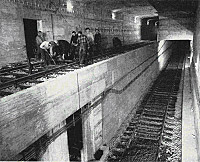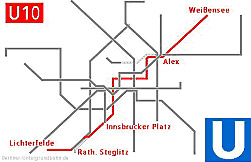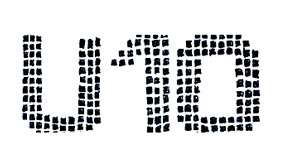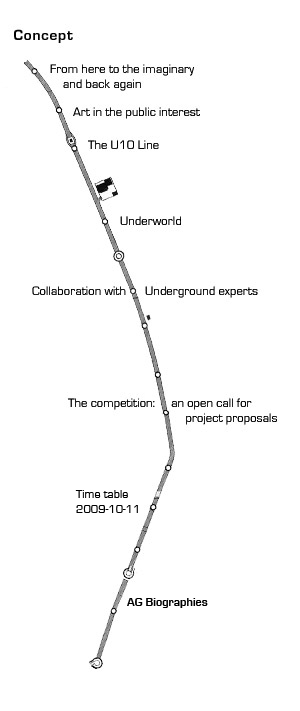 U10 – from here to the imaginary and back again
U10 – from here to the imaginary and back again
A concept by Sofia Bempeza, Ania Corcilius, Jacopo Gallico, Eva Hertzsch
and Adam Page for NGBK Berlin.
An art project financed by Berlin Council’s Department of Culture and supported by the Berlin Underground Train Company (BVG),
the Berlin Fenster (in-train TV) and by Wall AG.
"In this train of thought
spirits and ghosts are as real as atoms, particles, photons and quanta…"
Robert M. Pirsig
 Art in the public interest
Art in the public interest
50 years of public art in Alexanderplatz Underground Station in Berlin
came to an end in 2008. The next project on the Berlin Underground, U10
– from here to the imaginary and back again, sets a new focus on
the social and collaborative dimension of public art.
Our curatorial aim will be to find artists whose practice is group
orientated and who understand art as a means of communication and exchange.
We will seek to set U10 in the context of an internationally practiced
public art form which is increasingly produced in collaboration with
specific groups in society outside art institutions and a regular art
public. The resulting collaborations between artists and specific members
of the public seek to extend participation in cultural processes to
new areas of society. In this sense, art in public space art can become
art in the public interest.
Members of the Underground Network staff, passengers, kiosk and snack
bar owners, buskers and ticket traders become not only a potential audience
but also potential collaborators on a joint research of the Berlin Underground.


 The U10 Line
The U10 Line
The name U10 – from here to the imaginary and back
again refers to a line on the Berlin Underground which was originally
conceived in the 1930s but has never been finished. Today it remains
derelict, consisting of fragments of tunneling and abandoned, incompleted
stations. During the Cold War, the then West Berlin-owned Underground
Company (BVG) had to use part of the East Berlin-owned S1 line. The
BVG therefore started building the U10 line parallel to the S1 line
in order to be completely independent of the East German regime. Three
U10 stations were built but never completed because of the fall of the
Berlin Wall. The U10 line’s unknown existance (or non-existance)
and its fantastical and historical qualities as a mystical place and
a relic of divided Berlin offer the artists a number of points of approach.

top
↑
 Underworld
Underworld
The U10 project is interested in the whole of the Underground network,
seeing it as a parallel underworld, both real and imaginary. The Underground
is a real, living space, that is physically linked to people’s
everyday routine – it is a place of work, shelter, transportation
and encounter. Despite this familiarity, entering the Underground subtly
disrupts our sense of time and place. We disappear into a mysterious
world of black tunnels in the city’s subconscious.
Down here an unexpected and secretive mirror image of the city is registered
seismographically. The city’s inner spirit materialises. The artists’
role in the project U10 – from here to the imaginary and back
again is to examine this mirror image or spirit and its unknown,
hidden contexts.
top
↑
 Collaboration with Underground experts
Collaboration with Underground experts
The organisers aim to embed the U10 project into the social context of the Underground and, by doing so, discover what the Network really means to the identity of the city. They will seek to build lasting relationships to white and blue collar BVG Underground staff. The best place to speak to staff is at BVG’s many public events (for example spring and summer fetes, special trains, station and depot open days, tunnel walks etc), in the BVG museum and in the company’s main canteen. The criteria for the call for submissions will be developed in dialogue with BVG staff, two of whom will consult at the selection proceedure.
U10 will also seek to build lasting relationships with members of the public, for example with trainspotters passionate about public transport, with commuters who have the network „knowledge“ and with people who „trade“ (and sometimes sleep) on the platforms. The organisers will seek to continually involve a small number of Underground staff and the above mentioned members of the public as project experts and as consultants to the selected artists.
...
top
↑
 The competition – an open call for project proposals
The competition – an open call for project proposals
The organisers are looking for situation specific and/or participatory
projects which focus on the Berlin Underground and its staff and/or
users. They can range from being short, interventionistic artistic reactions
to specific occurances on the Underground to being long term collaborations
aimed at creating sustainable relationships to BVG staff and/or users
over a number of years. The competition sees members of staff, passengers,
kiosk and snack bar owners, buskers and ticket traders not only as a
potential audience but also as potential collaborators on a joint research
of the Berlin Underground.
top
↑ |




